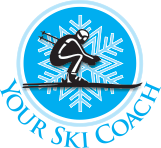Forward Pressure
How Much, Can you have too much?
Forward Pressure
How Much, Can you have too much?

Hello Rick
I am new to snowheads and also just been looking at your you tube video clip, which I liked, and will be practising your drills soon in the Alps as I will be out there for the whole season, can't wait. I slalom train here in the UK on a dry slope and the instructor is encouraging me to forward flex into the boot during a turn. However, another coach I have trained with gives me this answer "Forward pressure in the boot forces too much weight onto the front of the ski causing the tails to spin out and lose grip. Not great!"
Just wondered what are your thoughts on this. Thanks in anticipation.
Regards, Stuart
Your Ski Coach Home> Ask The Coach> Balance> Forward Pressure
Hi Stuart,
Thanks for writing, this is an excellent question. You might find this surprising to hear at first, but both of your coach's advice carries legitimacy. Please allow me to explain, in a bit of a wandering manner.
This topic has to do with balance management skills, a technical area of the sport that I, and most ski coaches, place very high emphasis on in their teachings. Being able to assume different states of balance while skiing allows a person to milk all the performance capabilities built into these magnificent skis we have to play with today.
Flexing into the front of the boot is a tactic that manages balance along what we call the Fore/Aft Balance Plane. The Fore/Aft Plane refers to how we are balancing forward or back on our skis. If we are centered along the Fore/Aft Plane, we have our weight evenly distributed on the ball and heel of our foot, and many good things happen:
1) The tips and tails of our skis enjoy similar pressure on the snow, and thus they can carve a very clean line through the turn, with the tail very closely following the track cut by the tip.
2) The foot, loaded in this manner, provides the ultimate balance platform for the skier.
3) The skier is able to stack solidly over his/her feet, allowing for a relaxing, strong and energy efficient skiing stance.
So why would we ever want to move into a Fore state of balance? Sometimes when freeskiing, and usually when racing, there is an urgency to launch a quick change of direction at the start of the turn. A race course does not provide the luxury of turning when you want to, it demands that you turn in a prescribed manner, and it punishes you if you don't turn quickly or sharply enough. During freeskiing, terrain, natural obstacles and other skiers at times make the same demands.
At those times, managing fore/aft balance can serve you well. Fore balancing directs more pressure to the front of the ski, and lightens the tail. The front of the ski bites into the snow more strongly, bends more drastically, and carves a sharper turn. At the same time, the more lightly pressured tail of the ski has a tendency to lose it's grip on the snow and drift sideways. The more forward balanced the skier becomes, the more drift tends to occur. That drift can be a good thing to, because it helps to sharpen the turn and get the skier/racer the direction change they need.
So, for that reason, early fore pressure can provide the powerful turn initiation needed in a race course, or in certain recreational skiing situations. The problem comes if the skier stays in that fore balanced position for the duration of the turn. Hyper loading the front of the skis is slow. It's like spiking the front brakes on a bicycle. And the non clean carving that drift produces is slow. So for racers, early tip loading should be abandoned latter in the turn for a more centered balance state that is more conducive to speed. For recreational skiing, a post turn initiation return to center provides for cleaner turns, and a stronger and more muscle relaxing stance.
Bottom line is;
use fore loading on an as needed basis, and only to the extent needed. Coaches may suggest over usage to students who have a problem with spending too much time aft balanced, as a means of reversing and rectifying the problem. Once a new movement pattern and balance platform has been embedded into the students muscle memory, supplanting the inefficient aft balance state, the coach can bring the student back to a neutral/centered state of balance. It's a legitimate teaching methodology. In my teachings, as you will find in my Building Blocks DVD Instructional Series, I show skiers how to ski well in all states of balance, both fore/aft and lateral, and to be able to change it at the drop of a hat. The result is the student can assume any state of balance they need, at any time they choose, to meet the need or desire they have at the moment. It's a confidence inspiring skill set that allows a person to do anything on their skis.
Stuart, I hope that helps.
Sincerely,
Rick Schnellmann
Your Ski Coach
